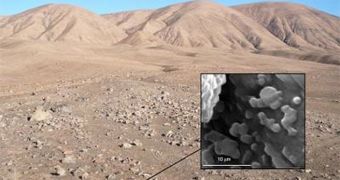A new discovery made in the Atacama Desert, the driest place on the planet, shows the numerous microorganisms can endure even in the harshest conditions. An international collaboration of experts was recently able to find a significant concentration of life just beneath the desert surface.
At first glance, the soils of Atacama are extremely dry and arid. Nothing can grow here, except for a very few species of highly-adapted plants. The region gets negligible amounts of yearly precipitations, and this is one of the reasons why it's so often used for hosting astronomical observatories.
But astrobiologists are interested in the Atacama Desert for another reason – its potential to act as a proxy for detecting life on other worlds. Particularly, they say, this region may look very much like Mars. If that is so, then the Red Planet may be able to hold life as well.
Working together with colleagues at the Catholic University of the North, in Chile, investigators from the Center of Astrobiology (CAB) in Spain managed to prove that, once life develops, it can find a way to endure. This conclusion is very important for a number of reasons.
The most important is that Mars was once a warm, wet planet. This implies that the neighboring world went through a phase where life had a chance to develop. Given that most of the Universe appears capable of promoting the emergence of life, it's not too much to assume that biology started to develop on Mars, too.
If potential microorganisms developing there had a chance to grab hold of the environment, then the subsequent destructions of Mars' favorable conditions may have had only a minimal effect of the lifeforms. In other words, theirs may have been just a struggle to adapt, not survive.
What is certain, though, is that the microbes or bacteria that develop did not remain on the irradiated surface of Mars. Most likely, they moved underground, similar to the microorganisms in Atacama.
Scientists are studying two regions of Earth at the same time – Atacama and Antarctica – in order to develop a model for where Mars' life may be hiding. The reason why both these areas are required for a comprehensive simulation is that Mars is both extremely dry, and very cold.
CAB investigators used a device called SOLID (Signs Of LIfe Detection) for their research. A similar instrument may be employed on future generations of astrobiology rovers destined for other worlds.
“If there are similar microbes on Mars or remains in similar conditions to the ones we have found in Atacama, we could detect them with instruments like SOLID,” INTA-CSIC expert Victor Parro says, quoted by Universe Today.
He adds that an improved version of the SOLID instrument is currently being developed for the ExoMars rover, which the European Space Agency (ESA) plans to deploy on the surface of the Red Planet by 2018.

 14 DAY TRIAL //
14 DAY TRIAL //